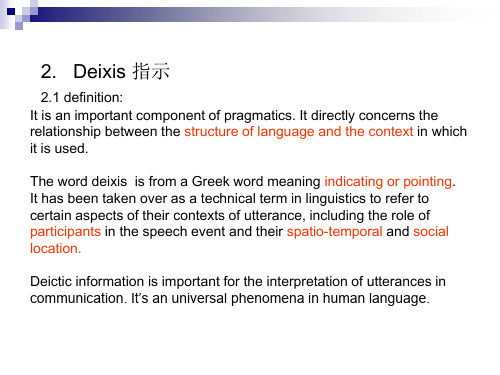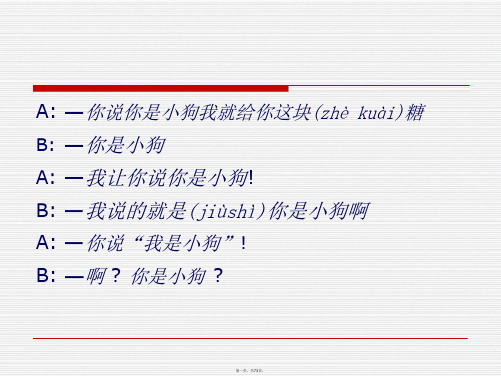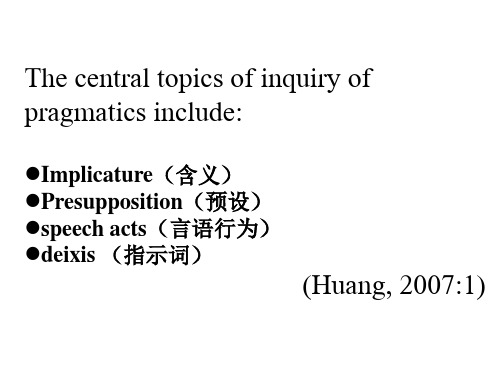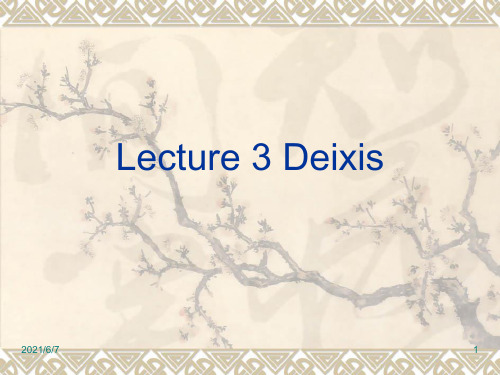语用学-deixis-指示代词PPT课件
合集下载
语用学 指示语

bring also are components of place deixis
Equivalents of these words can be found in Chinese, that is:这儿, 那儿,这个,那个,左和右,来和去,带走和拿来。
③除此之外,地点指示语可以是表示空间位置的副
• last指示的是上一章中讲述意识流的信息,或是传达该信 息的篇章部分 • I bet you haven’t heard this story… this指示接下来要叙述的故事,或是叙述故事的那个篇章部 分。
• Now I wonder through my garden indecisively, trying to hold on to the last days of late summer. • Now主要的是起到语篇的衔接作用 • Here we choose to define...as... • here 指示的是这部分要叙述的内容
地点指示语指话语涉及的地点或空间位置。 ①In English, location adverbs and demonstratives such as :here, there,this,that,left, right are typical place deixis.
②Besides, pairs of motion verbs such as come and go, take and
词,或由“介词+方位名词”组成表示空间位置的
介词短语,或者是“介词+物体”等组成的表示方
位的介词短语。
英语中的come和go可以表示言语时间参与者的 移动方向不同:
• He is coming. He is going.
《指示代词》PPT课件

11thisthat表示表示单数单数一个人或物概念一个人或物概念系动词用系动词用22thesethesethosethose表示表示复数复数两个及以上人或物概念两个及以上人或物概念系动词要用系动词要用are
指示代词
---
This is a tomato. 近 this
That is a carrot.
2. 远离我, that,those。
3.指单数, this,that。
4.指复数, these,those ---
单数问句:
What's this? 近 It's a cow.
What's that? It's a hen.
远
---
复数问句:
近
What are these? They are rabbits.
2.指代人或物时有单数,复数的区别: 1)this,that表示单数(一个人或物)概念,系动词用
is。 。
---
---
that
远
These are potatoes. these
近近
Those are horses
those
远
---
用法
近
this
远
近
these
远
that
those
---
用法
This is...
These are...
That is..
Those are...
魔法顺口溜:1. 靠近我, this, these。
---
一、定义和作用
指示代词 是用来确认或指定名词的代词,起指 示作用,或者用来代替前面已经提过的名词。 二、指示代词的分类 指示代词包括:this, that,these, those 1. 从时间和空间上对所指人有远和近的区别
指示代词
---
This is a tomato. 近 this
That is a carrot.
2. 远离我, that,those。
3.指单数, this,that。
4.指复数, these,those ---
单数问句:
What's this? 近 It's a cow.
What's that? It's a hen.
远
---
复数问句:
近
What are these? They are rabbits.
2.指代人或物时有单数,复数的区别: 1)this,that表示单数(一个人或物)概念,系动词用
is。 。
---
---
that
远
These are potatoes. these
近近
Those are horses
those
远
---
用法
近
this
远
近
these
远
that
those
---
用法
This is...
These are...
That is..
Those are...
魔法顺口溜:1. 靠近我, this, these。
---
一、定义和作用
指示代词 是用来确认或指定名词的代词,起指 示作用,或者用来代替前面已经提过的名词。 二、指示代词的分类 指示代词包括:this, that,these, those 1. 从时间和空间上对所指人有远和近的区别
语用学2 deictic words

2.2.4 discourse or textual deixis(篇章指示) Discourse deixis has to do with the use of expressions in some utterances in reference to a certain portion of the on-going discourse. Some expressions of discourse deixis are taken directly from time and place deictic.
The word deixis is from a Greek word meaning indicating or pointing. It has been taken over as a technical term in linguistics to refer to certain aspects of their contexts of utterance, including the role of participants in the speech event and their spatio-temporal and social location.
在有一名说话人和至少一名听话人参与的语言交际活动中,对参与者所 谈及的人物、事物、事件、过程和活动等做出确切的理解都必须把它们 和某些语境构成要素联系起来。使用和理解指示词语必须有一个明确的 参照点(point of reference)。在语言交际活动中,这个参照点都集中 在说话人身上,处于交际活动中心的人是正在说话的那个人。
Person deictic information is mainly provided by the system of the first, second and third person pronouns. It also includes possessive(所有格) and vocative(呼格) forms.
Deixis指示语 课件

? You can never tell what sex they are nowadays. (everyone)
? There we go. (idiomatic expression) ? I did this and that. (idiomatic expression)
第十二页,共73页。
modest.
第十九页,共73页。
‘We' means ‘you'
How are we feeling today?
When the speaker wants to show his concern and to share the problem with the addressee
咱爸咱妈 咱老爷子身体(shēntǐ)怎么样?
1.4 Different uses of deictic expressions
第三页,共73页。
1.1 Deixis
Deixis – indicating, pointing
Deictics Deictic words
Deictic expressions Yehoshua Bar- Hillel 1954
第二十页,共73页。
‘You':
indefinite pronoun in informal situations
My son is very naughty. Once you buy him
any toy, he will always break it into little
pieces before you know it.
(deictics, indexicals, indexical expressions)
? There we go. (idiomatic expression) ? I did this and that. (idiomatic expression)
第十二页,共73页。
modest.
第十九页,共73页。
‘We' means ‘you'
How are we feeling today?
When the speaker wants to show his concern and to share the problem with the addressee
咱爸咱妈 咱老爷子身体(shēntǐ)怎么样?
1.4 Different uses of deictic expressions
第三页,共73页。
1.1 Deixis
Deixis – indicating, pointing
Deictics Deictic words
Deictic expressions Yehoshua Bar- Hillel 1954
第二十页,共73页。
‘You':
indefinite pronoun in informal situations
My son is very naughty. Once you buy him
any toy, he will always break it into little
pieces before you know it.
(deictics, indexicals, indexical expressions)
商务英语语用学教程课件 Chapter 7

• E.g.: 1. At that time, everybody is very happy. 2. If I were you,...
3. We're going to Qindao this August. v.s We had a good time in Qindao this August.
• Some Asian languages, such as Japanese, Thai, Korean, and Javanese etc. have honorifics.
• E.g.: 1. Dr. Fawcett is conducting a lecture. 2. Would Your Highness care for a drink?
Table 7.1 Commonly Used Person Deixis
Person
Number
Nominative
Accusative
Possessive Pronoun
Reflexive Pronoun
first
Singular
I
me
my
Plural
we
us
our
second
singular
2005:194). Now, tomorrow and next year
are all time deixis.
• Deictic time adverbs refer to some pure
time deixis such as now, then, recently, soon etc.
• Non-deictic time adverbs are based on
语用学 deixisppt课件

30从语用学的角度出发虽然违背了指示语以说话人为中心的属性但说话人不以自身为指示中心而把参照点转移到听人或其他听众身上在这个过程中说话人以对方为指示照从对方的角度说从而产生了语用移情
Deixis
指 示 语
1
1. What is Deixis?
1) Knowledge is power. 2) I am the British Prime Minister. 3) The President met the British Prime
2
1.2 Defining Deixis
A technical term from Greek, meaning “pointing” via language.
Any linguistic form used to accomplish this “pointing” is called a deictic expression, which is also called an indexical.
(1)你想在事业上取得成功,你就必须
下一番苦功夫。
(2)他那刻苦钻研的精神你不能不佩服
。
(3)这个人性格内向,不善表达,你问
他十句,他才答你一句。
13
Place deixis: The encoding of temporal points or
spans relative to the location of the speaker Proximal: here Distal: there
5
Deictic expressions include definite noun phrases, personal pronouns, demonstratives, adverbs, tenses, etc.
Deixis
指 示 语
1
1. What is Deixis?
1) Knowledge is power. 2) I am the British Prime Minister. 3) The President met the British Prime
2
1.2 Defining Deixis
A technical term from Greek, meaning “pointing” via language.
Any linguistic form used to accomplish this “pointing” is called a deictic expression, which is also called an indexical.
(1)你想在事业上取得成功,你就必须
下一番苦功夫。
(2)他那刻苦钻研的精神你不能不佩服
。
(3)这个人性格内向,不善表达,你问
他十句,他才答你一句。
13
Place deixis: The encoding of temporal points or
spans relative to the location of the speaker Proximal: here Distal: there
5
Deictic expressions include definite noun phrases, personal pronouns, demonstratives, adverbs, tenses, etc.
《语用学deixis》PPT课件

centaurs, goblins, dragons, phoenix,…
In
pragmatic sense, we might think of reference as an act in which a speaker, or writer, uses linguistic forms to enable a listener or reader, to identify something. Those linguistic forms are referring expressions, which can be: Proper nouns: Shakespeare, Cathy Revuelto, Hawaii,…. Noun phrases: the author, the singer, the island, …or a man, a woman, a beautiful place,… Pronouns: he, it, her, them,…
A
horse is a four-legged solid-hoofed animal with flowing mane and tail, used from early times to carry loads, for riding, etc. My horse is white.
Unicorns,
Referennse and reference
•Referential and attributive uses
•Names and referents
•The role of co-text •Anaphoric reference
The
sense is the "cognitive significance" or "mode of presentation" of the referent. The sense of a proper name is whatever meaning it has, when there is no object to be indicated. The reference is the object that the expression refers to. The reference (or referent) of a proper name is the object it means or indicates.
语用学之指示语ppt课件

33
(28)《人妖生活不容易》 人妖在泰国虽然不能真正为主流社会所接受,但好在并
不遭受很大的歧视,学校里有人妖学生,商场里有人妖售 货员。据不完全统计,到20世纪90年代,泰国人妖的数量 已达2万多。
大多数人妖选择这条道路是为了挣钱,也有一些人则 是天生的性别错位,但走上这条路后,大多数人妖都发现, 她们不但要经历生理和心理的磨难,挣钱糊口也并非想象 中那样简单。泰国法律规定,人妖仍然是男性,不过人妖 在社会日常生活中定位为女性。人妖上公共卫生间会根据 自己当天的服饰选择,如果是女性装束,那么自然去女卫 生间。
“结婚的钱由谁来出?”,《实话实说》1996年11月
24
“我们”、“咱们”与“we”表示第 一人称复指关系,交际中存在三种用法:
A.包括交际的双方或多方,对方可以 在场,也可以不在场或根本不存在
B.不包括交际的对方 C.仅指交际的对方或听话人一方,不 包括说话人一方
25
(22)主持人:你管片的居民都怕不怕你? 观众二:我没把自己当成一个警察就老去管
蒂芬妮歌舞团成立之初只有3名职业人妖演员。她们 出于自身爱好,模仿当时著名的百老汇歌舞演出。由于模 仿逼真而且专业素质高,她们一炮打响并迅速走红。如今, 蒂芬妮歌舞团已有100多名全泰国最美艳的专业人妖演员, 名气堪比法国红磨坊,演出场地也从最初简陋不堪的小舞 台该在奢华的仿古希腊式建筑大剧场内,观众座位达千席。
26
(23)我们是学生,我们的主要任务是学习。
你们/你
语用功能:批评、劝诫,移情,从学生角度出 发,提高该话语的可接受性与劝说力
(24)我们认为,语用学与社会语言学之间存在很
多交叉现象。
我
语用功能:仅指作者本人,不包括读者在内的
(28)《人妖生活不容易》 人妖在泰国虽然不能真正为主流社会所接受,但好在并
不遭受很大的歧视,学校里有人妖学生,商场里有人妖售 货员。据不完全统计,到20世纪90年代,泰国人妖的数量 已达2万多。
大多数人妖选择这条道路是为了挣钱,也有一些人则 是天生的性别错位,但走上这条路后,大多数人妖都发现, 她们不但要经历生理和心理的磨难,挣钱糊口也并非想象 中那样简单。泰国法律规定,人妖仍然是男性,不过人妖 在社会日常生活中定位为女性。人妖上公共卫生间会根据 自己当天的服饰选择,如果是女性装束,那么自然去女卫 生间。
“结婚的钱由谁来出?”,《实话实说》1996年11月
24
“我们”、“咱们”与“we”表示第 一人称复指关系,交际中存在三种用法:
A.包括交际的双方或多方,对方可以 在场,也可以不在场或根本不存在
B.不包括交际的对方 C.仅指交际的对方或听话人一方,不 包括说话人一方
25
(22)主持人:你管片的居民都怕不怕你? 观众二:我没把自己当成一个警察就老去管
蒂芬妮歌舞团成立之初只有3名职业人妖演员。她们 出于自身爱好,模仿当时著名的百老汇歌舞演出。由于模 仿逼真而且专业素质高,她们一炮打响并迅速走红。如今, 蒂芬妮歌舞团已有100多名全泰国最美艳的专业人妖演员, 名气堪比法国红磨坊,演出场地也从最初简陋不堪的小舞 台该在奢华的仿古希腊式建筑大剧场内,观众座位达千席。
26
(23)我们是学生,我们的主要任务是学习。
你们/你
语用功能:批评、劝诫,移情,从学生角度出 发,提高该话语的可接受性与劝说力
(24)我们认为,语用学与社会语言学之间存在很
多交叉现象。
我
语用功能:仅指作者本人,不包括读者在内的
语用学Deixis

• (5) Social deixis: honorifics敬语 (forms
to show respect such as Professor Li)
• Big Sale Tomorrow.
• Deixis belongs to pragmatic study
since it reveals a very close relationship between language and context.
Deixis
CONTENT
• Exercise
• The notion of deixis
• Deictic usage VS non-deictic usage
• Different usages of deictic terms
EXERCISE
• a. Flying planes can be dangerous.
• Flying planes can be planes that are flying.飞行 中的飞机是危险的。 • To fly the plane is a dangerous behavior.飞飞机 是一件危险的事。
• b. Shooting of hunters is cruel.
• Shooting animals is a cruel behavior. • Shooting hunters is a cruel behavior.
• c. It’s the taste.
• It’s the taste I like • It’s the taste I dislike.
NOTION
• Deixis, derived from Greek, means “show”, “point” or “indicate” in English.
语用学课件

A: Mike has two pencils. (John has only two pencils and no more)
B: Mike has two pencils and perhaps two or more. (By adding “perhaps two or more”, the implicature disappears)
假设大家都知道John is an idiot.,但偏要嘲笑说John is a genius,即使不说这句话,改说下面任何一种同义结构:
()John is a mental prodigy. () John is an exceptionally clever human being. () John is an enormous intellect. () John is a big brain.
B: It is raining.
Semantic and literal meaning: his answer unrelated to the
question.
B’s implicature: the football match will be canceled as the
ground is wet and slippery after the rain.
预设分类(依据预设内容)
存在预设:用于陈述某人某事有一定性质的话语。 一般都预设讨论对象的存在。
话语的字面意义或语义组合。 听话人:根据相关语境因素进行推理,获取字面意
义以外的交际信息
在言语交际中,类似的字面意义或语义意义以外的隐含 信息就是我们要讨论的会话中的含义,即会话含义。
合作原则的内涵 格赖斯(Grice ,1975)认为:
B: Mike has two pencils and perhaps two or more. (By adding “perhaps two or more”, the implicature disappears)
假设大家都知道John is an idiot.,但偏要嘲笑说John is a genius,即使不说这句话,改说下面任何一种同义结构:
()John is a mental prodigy. () John is an exceptionally clever human being. () John is an enormous intellect. () John is a big brain.
B: It is raining.
Semantic and literal meaning: his answer unrelated to the
question.
B’s implicature: the football match will be canceled as the
ground is wet and slippery after the rain.
预设分类(依据预设内容)
存在预设:用于陈述某人某事有一定性质的话语。 一般都预设讨论对象的存在。
话语的字面意义或语义组合。 听话人:根据相关语境因素进行推理,获取字面意
义以外的交际信息
在言语交际中,类似的字面意义或语义意义以外的隐含 信息就是我们要讨论的会话中的含义,即会话含义。
合作原则的内涵 格赖斯(Grice ,1975)认为:
Unit-6---Deixis-指示语

Unit 6 Deixis
第1页,共21页。
Betty didn’t want to go to school, so she called her teacher posing as her father. Betty: Little Betty is not feeling well today, she needs to ask leave for the day. Teacher: To whom am I speaking?
CT (coding time): the time of the “ communication act” 编码时间 RT (receiving time) 接受时间
I’m in Nanjing now.
(Here “now” can be the CT or RT)
第15页,共21页。
4. Social deixis
Let us/ Let’s
Let us know the time of your arrival. (exclusive-of-addressee)
Let us try again. (inclusive/exclusive-of-addressee)
Let’s go to the cinema. (inclusive-of-addressee)
第12页,共21页。
2. Place deixis
Place deixis concerns the encoding of spatial location relative to the location of the participants in the speech event. Open the window behind you, please!
第1页,共21页。
Betty didn’t want to go to school, so she called her teacher posing as her father. Betty: Little Betty is not feeling well today, she needs to ask leave for the day. Teacher: To whom am I speaking?
CT (coding time): the time of the “ communication act” 编码时间 RT (receiving time) 接受时间
I’m in Nanjing now.
(Here “now” can be the CT or RT)
第15页,共21页。
4. Social deixis
Let us/ Let’s
Let us know the time of your arrival. (exclusive-of-addressee)
Let us try again. (inclusive/exclusive-of-addressee)
Let’s go to the cinema. (inclusive-of-addressee)
第12页,共21页。
2. Place deixis
Place deixis concerns the encoding of spatial location relative to the location of the participants in the speech event. Open the window behind you, please!
语用学 2.deixis

Time deixis: The encoding of temporal points or spans relative to the time of speaking (the coding time as opposed to the receiving time) Proximal: now Distal: then Proximal: present tenses Distal: past tenses
(=你们 (3)同志,咱们(=你们)这儿有海尔电 )同志,咱们(=你们) 冰箱吗? 冰箱吗? (=你 对小孩)别哭, (4)咱们(=你,对小孩)别哭,妈妈给 )咱们(= 你拿好吃的。 你拿好吃的。
Q. 汉语中哪些情况下第二人称指示信 息可以用第一人称指示语来表达?? 息可以用第一人称指示语来表达?? 这种现象的语用学解释?? 这种现象的语用学解释??
1.2 Defining Deixis
A technical term from Greek, meaning “pointing” via language. Any linguistic form used to accomplish this “pointing” is called a deictic expression, which is also called an indexical. A deictic expression is used to indicate something in the immediate context. So a deictic expression encodes information in context (Yule, 1996)
社交指示(社会指示) 社交指示(社会指示)
语言中的社交指示信息,根据菲尔默( 语言中的社交指示信息,根据菲尔默(Fillmore) ) 的意见,可以在下面几个方面得到反映: 的意见,可以在下面几个方面得到反映: A 人称标记,如语言中的代词等的应用。 人称标记,如语言中的代词等的应用。 B 不同的言语平面(speech levels),如坦率或礼 不同的言语平面( ),如坦率或礼 ), 貌的言谈、敬语或谦语等的认别。 貌的言谈、敬语或谦语等的认别。 C 谈话场合,如正式与非正式场合、严肃与随便场 谈话场合,如正式与非正式场合、 合的区别。 合的区别。 D 人名、职务和亲属的称谓,如根据说话人、听话 人名、职务和亲属的称谓,如根据说话人、 人和第三者的关系反映出不同的称谓表达方式。 人和第三者的关系反映出不同的称谓表达方式。 E 作为社交行为的言语表现方式,如问候、道谢等 作为社交行为的言语表现方式,如问候、 F 配合其他社交行为而使用的言语表现方式。 配合其他社交行为而使用的言语表现方式。 G 说话人运用言语手段向听话人发出的种种指示信 息。
1. Deixis指示语

When the speaker wants to show his concern and to share the problem with the addressee
咱爸咱妈
咱老爷子身体怎么样?
‘You‟:
indefinite pronoun in informal situations My son is very naughty. Once you buy him any toy, he will always break it into little pieces before you know it.
(2) Listen, I'm not disagreeing with you but
with you, and not about this but about this.
(3) Meet me here a week from now with a
stick about this big.
(4) Arriving at 11:30am tomorrow.
John loves me. me: deictic expression the person who is uttering the sentence: deictic information
The meaning of deictic expressions cannot be captured by truth-conditional semantics, and their interpretation must depend on analysis of the context of utterance in which they occur.
‘We‟ means „I‟
咱爸咱妈
咱老爷子身体怎么样?
‘You‟:
indefinite pronoun in informal situations My son is very naughty. Once you buy him any toy, he will always break it into little pieces before you know it.
(2) Listen, I'm not disagreeing with you but
with you, and not about this but about this.
(3) Meet me here a week from now with a
stick about this big.
(4) Arriving at 11:30am tomorrow.
John loves me. me: deictic expression the person who is uttering the sentence: deictic information
The meaning of deictic expressions cannot be captured by truth-conditional semantics, and their interpretation must depend on analysis of the context of utterance in which they occur.
‘We‟ means „I‟
Lecture-3-Dexis

3) The bank is two hundred yards away from the railway station. 4) It is 200 meters away.
2021/6/7
2
Main points
❖ Deixis as a component of pragmatic study ❖ Classification: person deixis, place dexis, time
❖ who is speaking
❖ the time or place of speaking
❖ the gestures of the speaker, or
❖ the current location in the discourse.
2021/6/7
8
❖ Lyons (1977,637) describe DEIXIS as:
the location and identification of persons, objects, processes and activities being talked about or referred to, in relation to the spatiotemporal context created and sustained by the act of utterance and the participation in it.
❖ The term is borrowed from the Greek word for
“pointing” or “indicating”. Any linguistic form
used to accomplish this “pointing” is called a
2021/6/7
2
Main points
❖ Deixis as a component of pragmatic study ❖ Classification: person deixis, place dexis, time
❖ who is speaking
❖ the time or place of speaking
❖ the gestures of the speaker, or
❖ the current location in the discourse.
2021/6/7
8
❖ Lyons (1977,637) describe DEIXIS as:
the location and identification of persons, objects, processes and activities being talked about or referred to, in relation to the spatiotemporal context created and sustained by the act of utterance and the participation in it.
❖ The term is borrowed from the Greek word for
“pointing” or “indicating”. Any linguistic form
used to accomplish this “pointing” is called a
- 1、下载文档前请自行甄别文档内容的完整性,平台不提供额外的编辑、内容补充、找答案等附加服务。
- 2、"仅部分预览"的文档,不可在线预览部分如存在完整性等问题,可反馈申请退款(可完整预览的文档不适用该条件!)。
- 3、如文档侵犯您的权益,请联系客服反馈,我们会尽快为您处理(人工客服工作时间:9:00-18:30)。
BA5 CK
B. Deictic modifier + Non-
deictic name (measure word)
A
B C
MAIN 主页
Examples:
this/that morning/afternoon/week/month/year next/last Mond子a页y/J3anuary/February/decade/century
4
A. Time adverbials
Examples: now, then, today, yesterday, tomorrow, soon, recently, two days ago, in three minutes, from now on, right away
• now — the time point of speaking today • yesterday — the day before that of speaking • tomorrow— the day after that of speaking • (two days)ago — (two days) before the time of speaking
MAIN
• Had I arrived a little earlier at the airport…
BA9 CK
Non-Deictic Usages
When the reference point of time deixis is a fixed time origin rather than the time of speaking, it is used non-deicticly. Calendric usages are examples of non-deictic usages.
speaking is used as the deictic center. So,
present tense is used for the event happening
A
at/during the time of speaking, past tense for the
event happening before the time of speaking.
6
C. Tense of verbs
(a grammatical category)
Examples:
A
Mary is reading on the lakeside.
(Happening at the time of speaking)
B
I wrote a letter to him.
(Happening before the time of speaking)
BA8 CK
C. Tense of verbs
(a grammatical category)
(a) Historical Present:
using present tense to refer to past events, bringing
the historical event closer to the addressee and vivid
A
to life.
(b) Subjunctive Mood:
B
Use past tense to refer to the events that are
impossible to be realized or far away from the reality.
C
Examples:
• If I were you, I…
C
I’m going to see the movie.
MAIN
(Happening after the time of speaking)
BA7 CK
C. Tense of verbs
(a grammatical category)
As a rule, in deictic use of tense, the time of
2
Time expressions can be used deicticly, when the speaker uses his own time of speaking as the reference time, or non—deicticly when the fixed time of an important event is used as the reference point of time.
3
Deictic Usages
The following is an illustration of the time deixis i n deictic uses, that is, the time of speaking is used as the reference point:
A. Time adverbials B. Deictic modifier + Non-deictic name (measurቤተ መጻሕፍቲ ባይዱ word) C. Tense of verbs (a grammatical category)
Deixis
1. Time deixis
• Deictic usages • Non-deictic usages • Pre-emptiveness of Deictic Words • Factors Influencing Choices between
Deictic and Non-deictic Usages
2. Person deixis
• First person deixis • Second person deixis • Third person deixis
By 陈静宜 柳晨曦 杨沁玉 余昕钰 袁邑婷
Powe张rp金oin张t Te秦mp张la玉tes梅 张扬红
Page 1
Time Deixis
B
However, this rule is sometimes violated in order
C
to achieve pragmatic effect.
MAIN
The following are two typical examples of deictic
projection or functional variation of tenses.
B. Deictic modifier + Non-
deictic name (measure word)
A
B C
MAIN 主页
Examples:
this/that morning/afternoon/week/month/year next/last Mond子a页y/J3anuary/February/decade/century
4
A. Time adverbials
Examples: now, then, today, yesterday, tomorrow, soon, recently, two days ago, in three minutes, from now on, right away
• now — the time point of speaking today • yesterday — the day before that of speaking • tomorrow— the day after that of speaking • (two days)ago — (two days) before the time of speaking
MAIN
• Had I arrived a little earlier at the airport…
BA9 CK
Non-Deictic Usages
When the reference point of time deixis is a fixed time origin rather than the time of speaking, it is used non-deicticly. Calendric usages are examples of non-deictic usages.
speaking is used as the deictic center. So,
present tense is used for the event happening
A
at/during the time of speaking, past tense for the
event happening before the time of speaking.
6
C. Tense of verbs
(a grammatical category)
Examples:
A
Mary is reading on the lakeside.
(Happening at the time of speaking)
B
I wrote a letter to him.
(Happening before the time of speaking)
BA8 CK
C. Tense of verbs
(a grammatical category)
(a) Historical Present:
using present tense to refer to past events, bringing
the historical event closer to the addressee and vivid
A
to life.
(b) Subjunctive Mood:
B
Use past tense to refer to the events that are
impossible to be realized or far away from the reality.
C
Examples:
• If I were you, I…
C
I’m going to see the movie.
MAIN
(Happening after the time of speaking)
BA7 CK
C. Tense of verbs
(a grammatical category)
As a rule, in deictic use of tense, the time of
2
Time expressions can be used deicticly, when the speaker uses his own time of speaking as the reference time, or non—deicticly when the fixed time of an important event is used as the reference point of time.
3
Deictic Usages
The following is an illustration of the time deixis i n deictic uses, that is, the time of speaking is used as the reference point:
A. Time adverbials B. Deictic modifier + Non-deictic name (measurቤተ መጻሕፍቲ ባይዱ word) C. Tense of verbs (a grammatical category)
Deixis
1. Time deixis
• Deictic usages • Non-deictic usages • Pre-emptiveness of Deictic Words • Factors Influencing Choices between
Deictic and Non-deictic Usages
2. Person deixis
• First person deixis • Second person deixis • Third person deixis
By 陈静宜 柳晨曦 杨沁玉 余昕钰 袁邑婷
Powe张rp金oin张t Te秦mp张la玉tes梅 张扬红
Page 1
Time Deixis
B
However, this rule is sometimes violated in order
C
to achieve pragmatic effect.
MAIN
The following are two typical examples of deictic
projection or functional variation of tenses.
